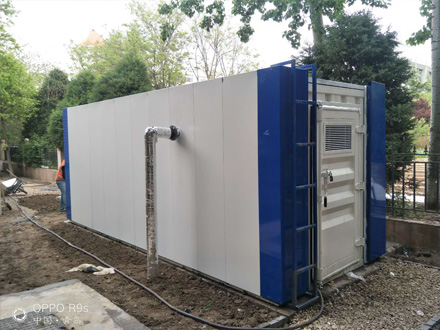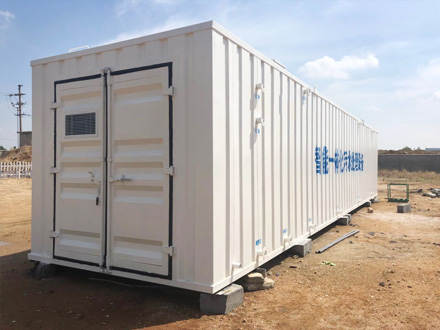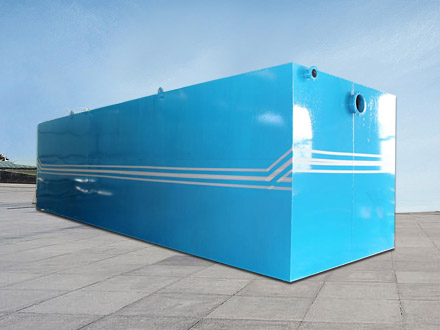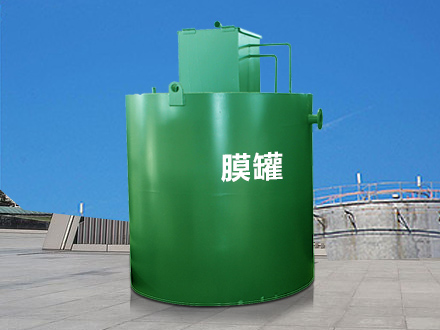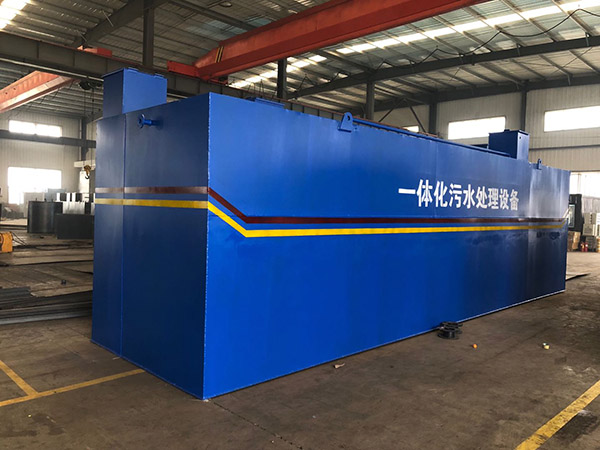概述:
mbr膜一体化污水处理设备采用国际先进的生物处理工艺,集去除BOD5、COD、NH3-N于一身,具有技术性能稳定可靠,处理效果好,投资省,占地少,维护方便等优点。我公司也可根据客户要求同时配套中水回用设备。
名称:mbr膜一体化污水处理设备
主体:碳钢主体制作
工艺:AO/A2O/MBR膜
使用范围:生活污水、养殖屠宰废水、
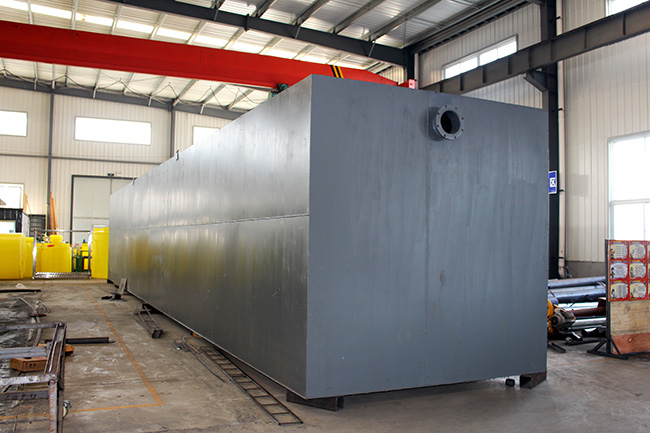
产品特点
1、本设备,埋设于地表以下,设备上面的地表可作为绿化或其他用地,不需要建房及采暖、保温。
2、二级生物接触氧化处理工艺均采用推流式生物接触氧化,其处理效果优于完全混合式或二级串联完全混合式生物接触氧化池。并比活性污泥池体积小,对水质的适应性强,耐冲击负荷性能好,出水水质稳定,不会产生污泥膨胀。池中采用新型弹性立体填料,比表面积大,微生物易挂膜,脱膜,在同样有机物负荷条件下,对有机物去除率高,能提高空气中的氧在水中溶解度。
3、生化池采用生物接触氧化法,其填料的体积负荷比较低,微生物处于自身氧化阶断,产泥量少,仅需三个月(90天)以上排一次泥(用粪车抽吸或脱水成泥饼外运)。
4、该地埋式生活污水处理设备的除臭方式除采用常规高空排气,另配有土壤脱臭措施。
5、整个设备处理系统配有全自动电气控制系统和设备故障报警系统,运行安全可靠,平时一般不需要专人管理,只需适时地对设备进行维护和保养。
设备使用方法
1、 能够处理生活系统综合性废水及其相类似的有机污水;
2、 全套装置施工简单、操作容易,所有机械设备均为自动化控制,全部装置可设置于地表以下;
3、 管理维护方便,设备配有全自动控制系统。使用寿命30年以上。
设备工艺
根据现有的水质水量,目前对于污水处理工艺一般有以下几种:
1、 物化处理
物化法常作为一种预处理的方法应用于污水处理,预处理的目的是通过回收废水中的有用成分,或对一些难生物降解物进行处理,从而达到去除有机物,提高生化性,降低生化处理负荷,提高处理效率。一般常用的物化法有絮凝沉淀(气浮)、吸附法等。
1) 絮凝沉淀
废水中含有胶体、酯类及悬浮物,使废水呈高分散系胶体溶液,这种胶体一般较稳定,治理这类废水首先要破坏其胶体状态。化学絮凝法正是通过药剂的物理化学作用,破坏废水胶体,使分散状态有机物脱稳、凝聚,形成聚集状态粗颗粒物质从水中分离而出。
在废水处理研究中,絮凝沉淀法因其可有效降低废水浊度和色度,能去除多种高分子有机物而被广泛采用。近年来,絮凝剂开发从传统无机絮凝剂发展到无机高分子,有机高分子絮凝剂,目前正在进一步探讨微生物絮凝剂。
2) 吸附法
吸附剂的种类很多,有活性炭、大孔树脂、活性白土、硅藻土等。在有机废水中常用的吸附剂有活性炭和大孔树脂。虽然活性炭具有较高的吸附性,但由于再生困难、费用高而在国内较少使用。
2、 化学处理
化学氧化法分为两大类,一类是在常温常压下利用强氧化剂(如过氧化氢、高锰酸钾、次氯酸盐、臭氧等) 将废水中的有机物氧化成二氧化碳和水;另一类是在高温高压下分解废水中有机物,包括超临界水氧化和湿空气氧化工艺,所用的氧化剂通常为氧气或过氧化氢,一般采用催化剂降低反应条件,加快反应速率。
化学氧化法反应速度快、控制简单,但成本较高,通常难以将难降解的有机物一步氧化到无机物质,而且目前对中间产物的控制的研究较少。该技术也常常作为生化处理的预处理方法使用。 其主要的方法有:
1) Fenton 氧化法
Fenton 试剂具有很强的氧化能力,因此Fenton 氧化法在处理废水有机物过程中发挥了巨大的作用。但由于体系中含有大量的Fe2 + 离子,H2O2 的利用率不高,使有机物降解不完全。
2) 臭氧氧化法
臭氧在水处理方面具有氧化能力强,反应速度快,不产生污泥,无二次污染等特点,在去除合成洗涤剂以及降低水中的BOD、COD 等方面都具有特殊的效果。臭氧对难降解有机物的氧化通常是使其环状分子的部分环或长链分子部分断裂,从而使大分子物质变成小分子物质,生成易于生化降解的物质,提高废水的可生化性。
3) 电化学氧化法
电化学氧化又称电化学燃烧,它是在电极表面的电氧化作用下或由电场作用而产生的自由基作用下使有机物氧化。电化学氧化分为直接电化学氧化和间接电化学氧化。直接电化学氧化是使难降解有机物在电极表面发生氧化还原反应。
3、 生物处理技术
生物处理技术是一般有机废水处理系统中最重要的过程之一,是利用微生物,主要是细菌的代谢作用,氧化、分解、吸附废水中可溶性的有机物及部分不溶性有机物,并使其转化为无害的稳定物质从而使水得到净化的技术。在现代的生物技术处理过程中,主要有好氧生物氧化、兼氧生物降解及厌氧消化降解这三类,生物处理技术由于经济可行、无二次污染等特点,已越来越引起重视。
长期以来好氧生物处理技术,尤其是活性污泥法一直是我国污水处理的主体工艺,它具有处理效率高、出水水质好的特点,但它也存在能耗高、运行费用大、剩余污泥产量多等缺点。厌氧生物处理技术因其具有能耗低、污泥产量少的特点,废水厌氧生物处理是环境工程与能源工程中的一项重要技术,是有机废水强有力的处理方法之一。虽然厌氧处理有一些优点,但是厌氧出水很难直接达到排放标准,一般用于高浓度有机污水的前段生物处理,因此后段生物处理仍然必须通过好氧处理才能达到排放标准。
处理工艺选择
综合上述处理介绍,对于生活污水处理工艺优先选择生物处理技术为主要处理工艺,主要原因是生物处理工艺运行费用省,处理效果好。
适用范围
1、 宾馆、饭店、疗养院、医院;
2、 住宅小区、村庄、集镇;
3、 车站、飞机场、海港码头、船舶;
4、 工厂、矿山、部队、旅游点、风景区;
5、 与生活污水类似的各种工业有机废水。
安装、使用、维护
1、 基础:WSZ系列设备如放置在地坪以上,只需准备一块与设备外形相同的混凝土地坪作为基础。基 础承压必须大于4T/m2,也同时要求水平、平整。
如设备埋于地坪以下,基础标高必须小于或等于设备标高并保证下雨不积水,基础一般是素混凝土(是否配筋视当地地质情况而定)。
2、安装:根据安装图就位,各箱体依次就位,箱体的位置、方向不能放错,互相间距必须准确,并连接好管道。
3、 在设备内注入清水,检查各管道有无渗漏,若无则箱体四周覆土,直至设备检查孔,并平整地面。把电控箱控制线与水泵接通,电控箱与电源接通,接线时注意风机、电机的转向,必须与风机所指方向相同。
设备的构造
设备所有管道采用PVC管或不锈钢管,管道间连接用PVC粘结剂粘结或不锈钢焊接。
填料采用悬浮型生物填料作生物载体,生物量大、易挂膜、不结球、不堵塞。
Summary:
MBR membrane integrated sewage treatment equipment adopts the international advanced biological treatment process, which can remove BOD5, COD and nh3-n in one. It has the advantages of stable and reliable technical performance, good treatment effect, low investment, small footprint and convenient maintenance. Our company can also provide water reuse equipment according to customer's requirement.
Name: MBR membrane integrated sewage treatment equipment
Main body: made of carbon steel
Process: AO/A2O/MBR membrane
Application: domestic sewage, breeding and slaughtering wastewater,
Complete set of integrated sewage treatment equipment
Product features
1. The equipment is buried below the surface, and the surface above the equipment can be used as green or other land, without the need of building, heating and insulation.
2. The treatment process of secondary biological contact oxidation adopts the push-flow biological contact oxidation, and its treatment effect is better than that of the complete mixed biological contact oxidation tank or the two-stage tandem complete mixed biological contact oxidation tank. Compared with activated sludge tank, the volume is smaller, the adaptability to water quality is strong, the impact load resistance is good, the effluent water quality is stable, will not produce sludge expansion. New elastic stereoscopic packing is adopted in the pool, with large specific surface area, and microorganisms are easy to hang the film and remove the film. Under the same load condition of organic matter, the removal rate of organic matter is high, and the solubility of oxygen in air can be improved in water.
3. The biochemical pool adopts the biological contact oxidation method. The volume load of the filler is relatively low, and the microorganism is in the stage of its own oxidation.
4. The deodorization method of the buried domestic sewage treatment equipment adopts conventional high-altitude exhaust and is equipped with soil deodorization measures.
5. The whole equipment processing system is equipped with automatic electrical control system and equipment fault alarm system. It is safe and reliable in operation.
Equipment usage
1. Able to treat the comprehensive wastewater of the living system and similar organic sewage;
2. The complete set of equipment is simple to construct and easy to operate. All mechanical equipment is automatically controlled and all devices can be set below the surface;
3. The equipment is equipped with automatic control system for convenient management and maintenance. Service life of more than 30 years.
Process equipment
According to the existing water quality and quantity, there are generally the following sewage treatment processes:
1. Materialized treatment
Physicochemical method is often used in sewage treatment as a pretreatment method. The purpose of pretreatment is to remove organic matter, improve biochemical properties, reduce biochemical treatment load and improve treatment efficiency by recycling useful components in wastewater or treating some refractory biodegradable substances. The commonly used physical and chemical methods include flocculation precipitation (air floatation), adsorption, etc.
1) flocculation and precipitation
The wastewater contains colloids, esters and suspensions, making the wastewater a highly dispersed colloidal solution, which is generally more stable. The chemical flocculation method is to destroy the colloid of waste water through the physical and chemical action of agents, so that the organic matter in the dispersed state can be de-stabilized and condensed, and the coarse particulate matter in the aggregation state can be separated from the water.
Flocculation sedimentation is widely used in wastewater treatment because it can effectively reduce the turbidity and chromaticity of wastewater and can remove a variety of macromolecular organics. In recent years, the development of flocculants has changed from traditional inorganic flocculants to inorganic and organic polymer flocculants.
2) adsorption method
There are many kinds of adsorbents, such as activated carbon, macroporous resin, activated clay, diatomite and so on. The adsorbents commonly used in organic wastewater are activated carbon and macroporous resin. Although activated carbon has a high adsorption, but because of difficult regeneration, high cost and less use in China.
2. Chemical treatment
Chemical oxidation method is divided into two categories, one is under normal temperature and pressure using strong oxidants (such as hydrogen peroxide, potassium permanganate, hypochlorite, ozone, etc.) in the wastewater of organic oxidation into carbon dioxide and water; The other is the decomposition of organic matter in wastewater under high temperature and pressure, including the process of supercritical water oxidation and wet air oxidation. The oxidant used is usually oxygen or hydrogen peroxide. Generally, the catalyst is used to reduce the reaction condition and speed up the reaction rate.
Chemical oxidation reaction is fast and easy to control, but the cost is high, it is usually difficult to decompose difficult organic matter into inorganic matter in a single step, and the control of intermediate products is rarely studied. The technique is also often used as a pretreatment method for biochemical treatment. The main methods are:
1) Fenton oxidation method
Fenton reagent has a strong oxidation ability, so Fenton oxidation method plays an important role in the treatment of organic compounds in wastewater. However, because the system contains a large number of Fe2 + ions, the utilization rate of H2O2 is not high, so the organic degradation is not complete.
2) ozone oxidation method
Ozone has strong oxidation ability in water treatment, fast reaction speed, no sludge, no secondary pollution and other characteristics, in the removal of synthetic detergent and reduce BOD, COD and other aspects of water have special effect. The oxidation of refractory organics by ozone usually breaks part of the ring molecules or long chain molecules, so that the macromolecules become small molecules to generate biodegradable substances and improve the biodegradability of wastewater.
3) electrochemical oxidation method
Electrochemical oxidation, also known as electrochemical combustion, oxidizes organic matter under the action of electrooxidation on the electrode surface or free radicals generated by the action of electric field. Electrochemical oxidation is divided into direct electrochemical oxidation and indirect electrochemical oxidation. Direct electrochemical oxidation is a kind of REDOX reaction on the surface of electrode.
3. Biological processing technology
Biological treatment technology is one of the most important processes in the general organic wastewater treatment system. It is a technology that utilizes the metabolism of microorganisms, mainly bacteria, to oxidize, decompose and absorb the soluble organics and some insoluble organics in the wastewater, and converts them into harmless stable substances so as to purify the water. In the process of modern biotechnological treatment, there are mainly three categories: aerobic biooxidation, facultative biodegradation and anaerobic digestion and degradation.
For a long time, aerobic biological treatment technology, especially activated sludge process, has been the main process of sewage treatment in China. It has the characteristics of high treatment efficiency and good effluent quality. Anaerobic biological treatment of wastewater is an important technology in environmental engineering and energy engineering because of its low energy consumption and low sludge yield. Although anaerobic treatment has some advantages, it is difficult for anaerobic effluent to directly meet the discharge standard. Generally, it is used for the biological treatment of high concentration organic sewage in the first stage. Therefore, the biological treatment in the second stage must still go through aerobic treatment to reach the discharge standard.
Treatment selection
Based on the above treatment introduction, biological treatment technology is preferred as the main treatment process for domestic sewage treatment process. The main reason is that the biological treatment process has low operation cost and good treatment effect.
Scope of application
1. Hotels, restaurants, nursing homes and hospitals;
2. Residential communities, villages and market towns;
3. Stations, airports, seaports, docks and ships;
4. Factories, mines, troops, tourist spots and scenic spots;
5. All kinds of industrial organic wastewater similar to domestic sewage.
Installation, use and maintenance
1. Foundation: if WSZ series equipment is placed above the floor, only a concrete floor with the same appearance as the equipment is needed as the foundation. Foundation pressure must be greater than 4T/m2, but also horizontal and flat.
If the equipment is buried below the floor, the elevation of the foundation must be less than or equal to the elevation of the equipment and ensure that there is no rain or water. The foundation is generally plain concrete (whether the reinforcement depends on the local geological conditions).
2. Installation: according to the installation drawing, each box shall be placed in place successively. The position and direction of the box shall not be misplaced.
3. Pour clean water into the equipment to check whether there is leakage in each pipe. If there is no leakage, cover the box with soil until the inspection hole of the equipment and level the ground. Connect the control line of the electric control box with the water pump, connect the electric control box with the power supply, pay attention to the direction of the fan and motor when wiring, must be the same as the direction indicated by the fan.
Equipment construction
All pipes of the equipment are made of PVC or stainless steel, and the connection between pipes is made of PVC adhesive or stainless steel welding.
The packing adopts suspension biological packing as biological carrier, with large biomass, easy to hang film, no balling and no clogging.



